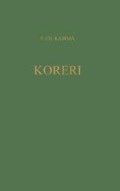Summary
A high degree of uncertainty, even with regard to the most elementary requirements of life, appears to be characteristic of Biak society. This is primarily the result of the infertile soil conditions and the geographical position of the Biak Islands, which hinders communications internally and with the Geelvink Bay area which is important for the supply of food. The isolated position and the poor communications, often only along seaways endangered by gales from the west or from the south-east, facilitated the development of a strong regionalism. The subcultural centers, the dialect-groups, villages and clans predominated. Frequent emigrations, contacts with the outer world on their distant raids in earlier times and later during their voyages to Tidore and as travelling blacksmiths, introduced foreign goods into the ceremonial exchange. An increasing amount of prestige became attached to the acquisition of these valuables, which were of such vital importance to the community. Marriages and the formation of groups were determined by offensive and defensive motives, and in later years by economic factors. Social classes could not maintain themselves due to the absence of class endogamy and the adoption of slaves on the one hand, and to the emphasis laid on personally gained prestige (achieved status versus ascribed status) on the other.
A strong feeling of dependence caused by the adverse natural environment was compensated for by the knowledge of magic spells, ancestorworship and a total ritual connected with their Supreme Being (The Sky (Firmament) or the Sun). There is a great difference for the Biak people between the “real” and the “ideal” world.
The founders of clans and recent ancestors take the place of the mythical demons and demi gods because there is a tendency to attribute the recovery of the secret of life and death to the ancestors. They even allow them to replace the Supreme Being (Manseren Nanggi) in the myths as a sign of their reduced dependence resulting from their knowledge of the secret, which is a condition of real power.
Only in the ritual connected with the offering to the Sky (Fan Nanggi) does the Biak tribe acquire a unity which transcends the subcultural borders. The unity of the Biak people is therefore determined by religion and not by politics and bears the character of a ritual community. The Utopian ideal, however, aims at the restoration of the original community and the suppression of rivalry.
Access this chapter
Tax calculation will be finalised at checkout
Purchases are for personal use only
Preview
Unable to display preview. Download preview PDF.
Literature
Arfak — the name given to the people of the mountains near Manokwari and formerly also to the inhabitants of the Biak interior. Arfak people (the Biak people call them Faksi) in the interior of the Island of Biak must have been quite numberous. M. W. Kaisjepo mentioned the keret (patricians): 1. Abidondifu; 2. Ansek; 3. Arwam; 4. Bubre; 5. Fureuw; 6. Kararibo; 7. Kmur; 8. Mandobar; 9. Mansimor; 10. Masosendifu; 11. Mnumumes; 12. Odyaba; 13. Orboi; 14. Rumanasen and 15. Smas.
hongi-voyages = annual voyages to cut down trees in West Seram, where the clandestine trade with Macassar still continued. A hongi was a fleet of cora-coras or large praus propelled by oars (Hall, D. G. E., A History of South East Asia, London 1964).
In the Biak-Numfor language the word raak is usually used instead of hongi. The meaning is always a headhunting expedition.
Rights and permissions
Copyright information
© 1972 Springer Science + Business Media B.V.
About this chapter
Cite this chapter
Kamma, F.C. (1972). The Setting. In: Koreri Messianic Movements in the Biak-Numfor Culture Area. Springer, Dordrecht. https://doi.org/10.1007/978-94-015-0742-4_2
Download citation
DOI: https://doi.org/10.1007/978-94-015-0742-4_2
Publisher Name: Springer, Dordrecht
Print ISBN: 978-94-015-0230-6
Online ISBN: 978-94-015-0742-4
eBook Packages: Springer Book Archive

